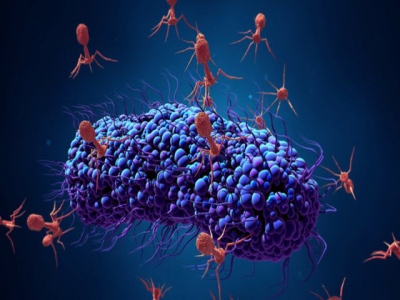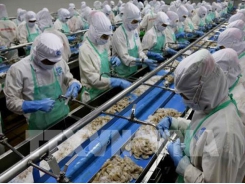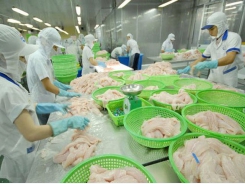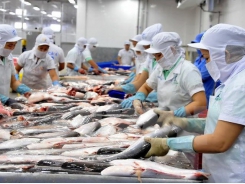Coating bacteriophage may boost stability, use as antibiotic alternative in aquafeed

Applying bacteriophage to fish feeding using a WPI coating may stabilize phage delivery and boost use over time, in water, and during fish digestion, says researcher.
A series of trials examined the use of bacteriophage as an edible coating applied to fish feed, said Nitin Nitin, associate professor with the University of California, Davis.
“Bacteriophage has been one of the options to treat bacterial infections in aquaculture and aquaponics but the technologies haven’t moved significantly forward,” he told FeedNavigator. There are some challenges to using bacteriophages that still needed to be addressed, he added.
“In aquaculture, the amount of phage that you need to introduce in the water system is very large, and if you introduce the bacteriophages on the feed itself they’re not very stable,” he said. “So that led us to the idea that we should look into ways to increase the stability of phages.”
In the series of in vitro studies, the researchers used an edible whey protein isolate (WPI) coating on fish feed to add and help stabilize the bacteriophage, Nitin said.
The goal of the project was to create a “bacteriophage-based edible antimicrobial coating” that could be used on fish feed to provide a “biological control strategy” to address disease in aquaculture systems, the researchers said.
The feed was analyzed to see how much of the phage would be lost during emersion in salt water and during a simulated digestion process, they said. It also was tested for its ability to reduce specific bacteria in an intestinal medium.
The coating was found to reduce leaching of the phage when the feed was exposed to salt water, and to improve the stability of phages during a simulated digestion process, they said. During the simulated intestinal process, coated phage significantly reduced target bacteria.
Why use coated bacteriophage in aquafeed?
Although interest in aquaculture is increasing, the industry faces financial losses annually from bacterial diseases, the researchers said. Antibiotics have been used to treat infections, however, other approaches are needed.
Bacteriophage could be one alternative as lytic bacteriophages are able to address specific pathogens, they added.
Using bacteriophage to address bacterial challenges in aquaculture production provides an alternative for fish producers, said Nitin.
“The advantage of bacteriophages, as compared to antibiotics, which are conventionally used, is that they can fight the challenge of antibiotic resistance in some cases,” he said. They “also provide an alternative to antibiotics for treating bacterial infection.”
Another advantage of using phages is that they not used as a therapeutic in humans, he said.
However, said Nitin, the use of cocktail or blend of several phages may be useful for a longer duration. Because bacteria can become resistant to single strains of phage.
“They both coexist in the environment and try to compete with each other,” he said. “That’s why people use a cocktail of phages, use three or four phages in combination to overcome the bias in the system.”
The researchers used a WPI coating with the bacteriophage to help stabilize the additive, he said. Previous research with the coating found that it helped protect phage against desiccation.
There could be other “film-forming protein polymers” or carbohydrate polymers that could also be used depending on available ingredients, he said.
Simulated feeding study details
During the trials, a biopolymer coating was created using WPI, glycerol and water and phage were added to the solution, the researchers said. Phage also was added to water and applied to feed to provide a control.
The researchers explored using both a spray coating and a dipping process to add the bacteriophage coating to commercially available fish feed to address the different ways the additive could be used, said Nitin.
The spray coating system could be easily scaled for industrial production, he said. “We started with dip coating [because] if this formulation was provided to fish farmers they might be able to do it on site,” he added.
To test the stability of the phage added to fish feed, feed samples were coated with phage either in the WPI mixture or in a water-based application, the researchers said. Coated fish feed was stored for a month and phage survival was noted on days 0, 7, 14, 21 and 28.
Feeds coated in phage using both methods also were exposed to a 3.5% salt solution for 30 minutes, 1 or 2 hours, they said. Phage activity was then measured to establish the amount remaining.
Phage also was tested for survival in a simulated digestive system, they said. A simulated gastric fluid (SGF) was prepared using sodium chloride, hydrochloride (HCl) and pepsin.
Phage applied in the different coating methods were added to the mixture and phage activity was measured every 30 minutes, they said.
Additionally, phage in the WPI coating was added to simulated intestinal fluid while facing a bacterial challenge, the researchers said. Samples were collected at 30 minutes, 1 hour and 2 hours to check for bacterial levels.
Results
Overall, use of the WPI-coating was found to improve the stability of phage remaining on feed pellets for a period of time, facing a 2-hour saltwater challenge and a digestive challenge, the researchers said. In the disease challenge, WPI-coated phage was able to reduce the amount of target bacteria by 3 to 5 log.
“Phage are, they’re made up a protein on the outside and just like anything we consume – it gets digested in the gastric environment,” said Nitin. “It may not be efficacious and may not be where it needs to be – what we found out was without a coating we were losing significant orders of magnitude more of the bacteriophages than with the coating approach and the coating protected it for a long period of time.”
When comparing the spray or dip coated fish feed, researchers found that the dipping process added a larger amount of the coating. However, the spray method applied a uniform coating.
When using the dip method, the WPI coating mixture added about 5.5 log PFU/pellet of the phages, the researchers said. The same process using a water-based coating added about 4.5 log PFU/pellet.
Using the airbrush system with the WPI coating added about 4.8 log PFU/pellet, and the water-based coating added less than 4 log PFU/pellet and the process was not used for the other tests, they said.
During the stability trials, the feed dipped in water containing the phages was considered the control, they said.
The dipped or sprayed feed pellets with the WPI-coated phages show a drop of 1.2 or 0.9 log PFU/pellet, respectively, following four weeks of storage, they said. Feed using the water-applied phage saw a drop of 3.5 log PFU/pellet.
In the saltwater challenge, phage rapidly left the feed without the WPI coating, the researchers said. Dip and spray WPI-coated feeds released similar amounts of phage.
Similarly, in the gastric digestion challenge water-applied phage degraded in the first 30 minutes, they said. Both spray and dipped WPI-coated feeds saw similar amounts of phage loss following the first hour of exposure but retained more than 3 log PFU/pellet.
During the disease challenge, feed with the WPI-coated bacteriophage was able to inactive about 3 to 5 log of the targeted bacteria, they said.
The researchers are already testing the edible bacteriophage in feeding trials with salmon and shrimp, said Nitin. However, that work is currently ongoing.
“There’s a significant promise to provide an alternative to antibiotics,” he said. “We're very excited about the follow-up work that we’re doing.”
Source: Aquaculture
Authors: K. Huang, N. Nitin
Related news
Tools

Phối trộn thức ăn chăn nuôi

Pha dung dịch thủy canh

Định mức cho tôm ăn

Phối trộn phân bón NPK

Xác định tỷ lệ tôm sống

Chuyển đổi đơn vị phân bón

Xác định công suất sục khí

Chuyển đổi đơn vị tôm

Tính diện tích nhà kính

Tính thể tích ao



 Vietnam to face competition from India in aquaculture…
Vietnam to face competition from India in aquaculture…  Vietnam targets US$10 billion from seafood exports in…
Vietnam targets US$10 billion from seafood exports in…